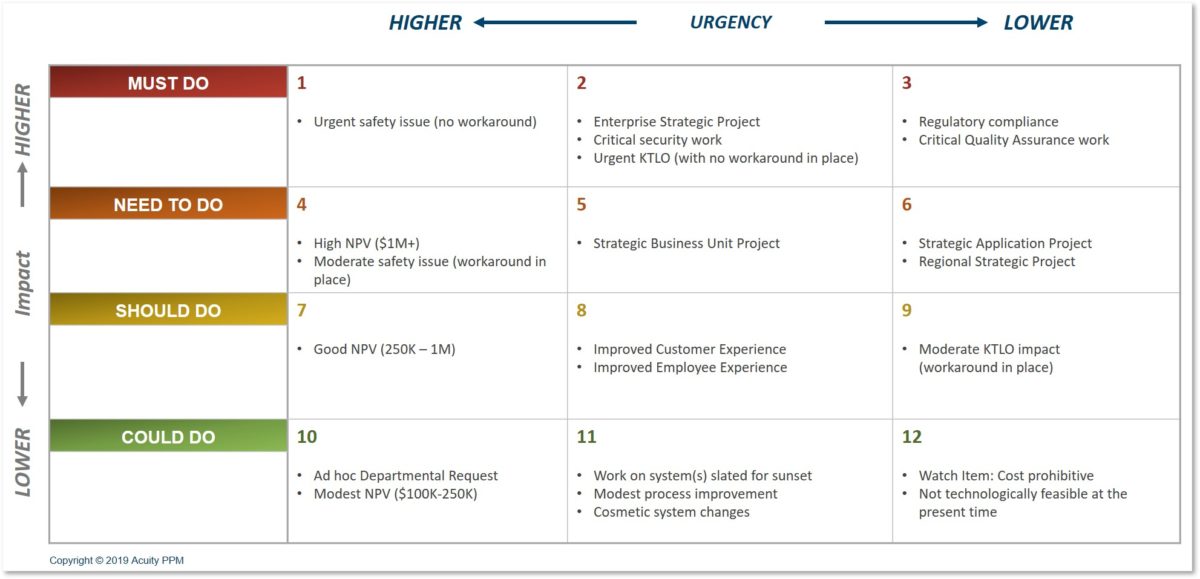
Not Urgent & Unimportant tasks/projects to be deleted Urgent & Unimportant tasks/projects to be delegated to someone else Not Urgent & Important tasks/projects to be scheduled on your calendar Urgent & Important tasks/projects to be completed immediately All of your day-to-day tasks and bigger projects will fall into one of these four quadrants: It helps you visualize all your tasks in a matrix of urgent/important. The Eisenhower Matrix is a simple tool for considering the long-term outcomes of your daily tasks and focusing on what will make you most effective, not just most productive.

That’s where the Eisenhower Matrix comes in. The findings suggest that if you keep the long-term importance of non-urgent tasks in view, you can overcome the pull toward urgent distractions and focus on what really matters. When participants were prompted to consider the consequences of their choices at the time of selection, they were significantly more likely to choose the important task over the urgent one.

If you're already feeling a time crunch, you’ll likely continue to prioritize tasks that keep you focused on the clock.īut there's good news too - the mere-urgency effect can be reversed. The same researchers found that self-described busy people were more likely to select urgent tasks with lower payouts because they were already fixated on task duration. We're more likely to prioritize tasks with a deadline over tasks without one regardless of their long-term payoffs.Īnd the effect is even more prominent in people who describe themselves as “busy”. This psychological quirk - dubbed the "Mere-Urgency Effect" - explains why we're so bad at task and time management. Across five separate experiments, researchers observed a curious pattern: our attention is drawn to time-sensitive tasks over tasks that are less urgent even when the less urgent task offers greater rewards. How do we decide which task to give our attention to at any given moment? Not very well, it turns out.Ī recent study in the Journal of Consumer Research set out to examine how people decide what to work on when faced with tasks of mixed urgency and importance.
Priority matrix image how to#
This article will walk you through why distinguishing between the Urgent and the Important is so critical, how the Eisenhower Matrix helps you do it, and how to apply the matrix to both your big-picture projects and everyday tasks using Todoist.

Want to be the president of the United States (hey, it worked for Eisenhower) Have a hard time delegating and/or saying no Have long-term goals but no time or energy to make progress on them This framework for prioritization helps you combat the “mere-urgency” effect (more on that later), eliminate time-wasters in your life, and create more mental space to make progress on your goals.įind yourself running around putting out fires all day (figuratively speaking)Īre busy but don’t feel like your work has a high impact Over 3 decades later in his best-selling book The 7 Habits of Highly Effective People, Stephen Covey repackaged Eisenhower’s insights into a simple tool to prioritize tasks, now known as the Eisenhower Matrix (also known as The Time Management Matrix, The Eisenhower Box, The Eisenhower Method, and The Urgent-Important Matrix). The urgent are not important, and the important are never urgent.” In a 1954 speech, Eisenhower quoted an unnamed university president who said, “I have two kinds of problems, the urgent and the important. How was Eisenhower able to rack up so many accomplishments that would have such a lasting impact on his country and the world? He understood the fundamental difference between the Urgent and the Important.

Eisenhower - five-star general during World War II and 34th president of the United States - was a productive guy.ĭuring his two terms as president of the United States, he led the construction of the Interstate Highway System, created NASA, signed into law the first major piece of civil rights legislation since the end of the Civil War, ended the Korean War, welcomed Alaska and Hawaii into the union, and managed to keep the Cold War with Russia cold.Īnd he did it all with panache - Eisenhower was Gallup’s most admired man of the year no less than twelve times. Eisenhower, 1961 address to the Century Associationĭwight D. “Who can define for us with accuracy the difference between the long and short term! Especially whenever our affairs seem to be in crisis, we are almost compelled to give our first attention to the urgent present rather than to the important future.”


 0 kommentar(er)
0 kommentar(er)
